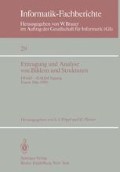Summary
Although the intense activity and revival of interest in speckle phenomena which occurred in the late sixties and early seventies has to some extent subsided, there are still a substantial number of papers appearing in the main optics journals. A large number of these have been concerned with further developments of existing or proposed applications of speckle to problems in engineering and astronomy. But papers have also been published reporting new experimental results and new theories.
One new theory (which will be discussed in detail) is concerned with the statistics of a particular class of non-Gaussian speckle patterns which have been found to arise when laser light is scattered from refractive index variations in turbulent fluids [1,2]. This theory is important because it is based on a reconsideration of the simple random walk model frequently used to derive statistical properties of intensity variations in speckle patterns. According to the random walk model the field at a point in a speckle pattern is considered to be the sum of a number of randomly phased contributions from the random medium or surface. It is usually stated that when a large number of scatterers contribute, the central limit theorem leads to a prediction of negative exponentially distributed intensity variations. Jakeman and Pusey have pointed out [2] that this need not always be true. If the number of scatterers fluctuates in a particular way then in the limit of a large mean number of scatterers the intensity should be a K-distribution. This distribution has been observed in a number of experiments [2].
Other non-Gaussian speckle patterns — those produced by a small number of scatterers or from polychromatic light sources have also been studied extensively recently in order to determine the feasibility of deducing surface roughness parameters from the speckle statistics (see for example [3–6]). Experiments have established that in both cases the statistical properties of the intensity are sensitive to surface parameters, but unfortunately, all the methods proposed appear to be rather complicated and dependent on the surface model used. So it is not yet clear whether these techniques will be of use to engineers.
Somewhat in contrast to this the technique of stellar speckle interferometry has already become well accepted in astronomy. A large number of measurements have been made successfully determining binary star separations and extensive developments of on-line processing systems have been carried out. Many of these are reported in reference [7].
Access this chapter
Tax calculation will be finalised at checkout
Purchases are for personal use only
References
G. Parry, P. N. Pusey, E. Jakeman and J. G. McWhirter, Opt.Commun. 22, 195 (1977).
E. Jakeman and P. N. Pusey, Phys.Rev.Lett. 40, 546 (1978).
J. Ohtsubo, and T. Asakura, Opt.Commun. 25, 315 (1978).
P. J. Chandley and H. M. Escamilla, Opt.Commun. 29, 151 (1979).
K. Nakagawa and T. Asakura, Appl.Opt. 18, 3725 (1979).
M. Giglio, S Musazzi and U. Perini, Opt.Commun. 28, 166 (1979).
J. Davis and W. J. Tango, E. “High Angular Resolution Stellar Interferometry” I.A.U Colloquium No.50). (Published by Chatterton Astronomy Dept., School of Physics, University of Sydney, NSW 2006, Australia).
Author information
Authors and Affiliations
Editor information
Editors and Affiliations
Rights and permissions
Copyright information
© 1980 Springer-Verlag Berlin · Heidelberg
About this paper
Cite this paper
Parry, G. (1980). Laser Speckle and Related Phenomena Current Developments. In: Pöppl, S.J., Platzer, H. (eds) Erzeugung und Analyse von Bildern und Strukturen. Informatik-Fachberichte, vol 29. Springer, Berlin, Heidelberg. https://doi.org/10.1007/978-3-642-67687-1_1
Download citation
DOI: https://doi.org/10.1007/978-3-642-67687-1_1
Publisher Name: Springer, Berlin, Heidelberg
Print ISBN: 978-3-540-10130-7
Online ISBN: 978-3-642-67687-1
eBook Packages: Springer Book Archive

